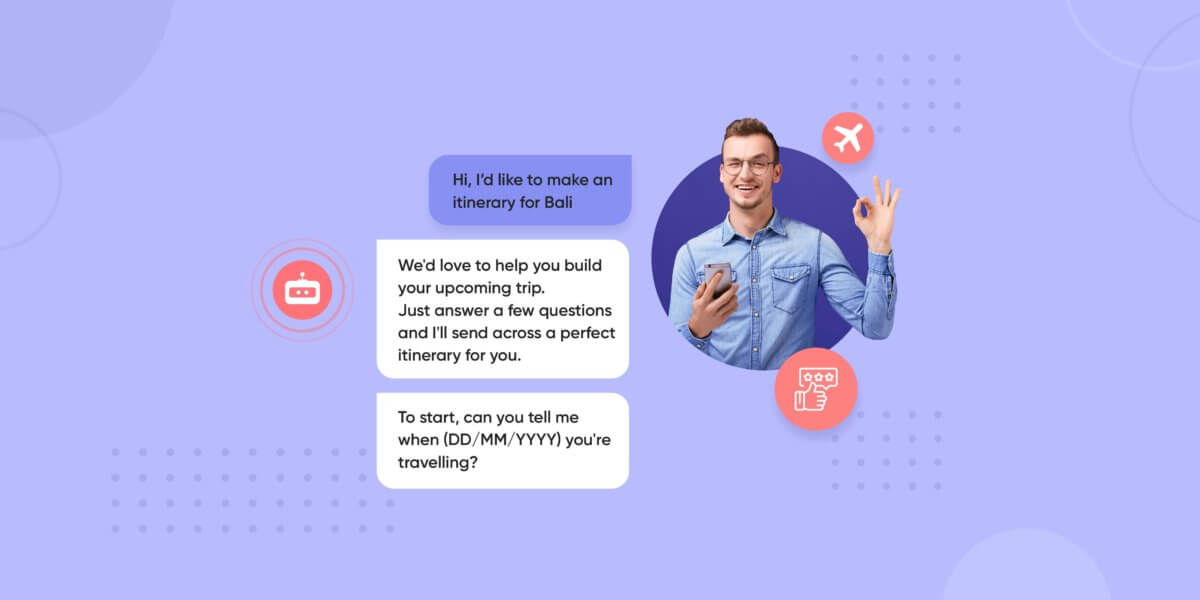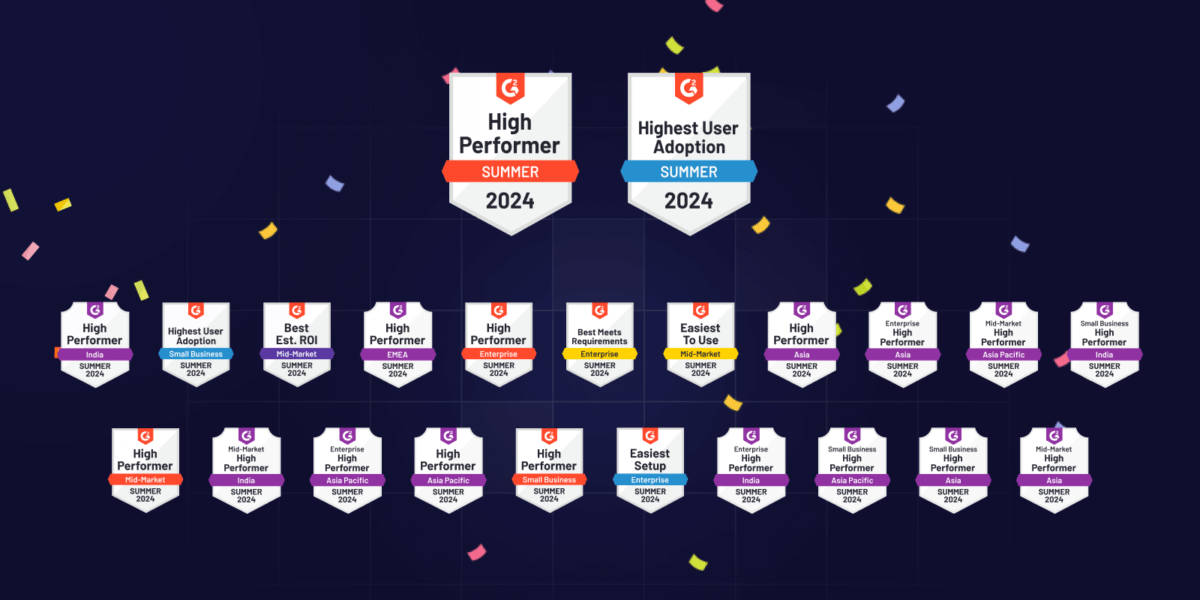How to Use Automation to Deliver a Seamless Client Experience?
- July 15th, 2025 / 3 Mins read
-
Aarti Nair

How to Use Automation to Deliver a Seamless Client Experience?
- July 15th, 2025 / 3 Mins read
-
Aarti Nair
What’s the cost of a clunky client experience?
Revenue, retention, and reputation and all at once.
Now flip that: what’s the payoff of a seamless, automated customer journey?
According to the Temkin Group, businesses earning $1 billion annually can generate an additional $700 million in just three years by improving their customer experience. For SaaS companies, that number jumps to $1 billion in extra revenue.
That’s not wishful thinking, but it’s a direct outcome of building smarter, friction-free experiences.
Here’s why: 86% of buyers say they’re willing to spend more for a better experience. Not more features. No more discounts. Just less hassle.
But delivering that kind of smooth, intuitive experience at scale?
That’s where automation steps in. In this blog, we’ll break down how you can use automation not just to reduce response times, but to create interactions that feel personal, timely, and effortless—no matter how many customers you’re handling.
Why a Seamless Client Experience Matters?
Client experience isn’t just a feel-good metric. It directly affects your bottom line.
According to a report by PWC, 73% of customers say experience is an important factor in their buying decisions, right behind price and product. In the B2B world, where the stakes are higher and relationships longer, that number becomes even more critical.
And here’s the kicker: companies that provide a consistent, seamless experience across channels retain 89% of their customers, while those with weaker omnichannel strategies retain only 33% (Aberdeen Group).
Expectations Have Shifted—Especially in SaaS
Gone are the days when clients would tolerate long onboarding calls, delayed support replies, or generic messaging. Today’s B2B buyers expect the same level of speed, ease, and personalisation they get from their B2C experiences.
In SaaS, particularly, there’s little room for error. With short trial periods, self-serve journeys, and usage-based pricing, the margin for friction is razor-thin. A single delay in onboarding or a missed follow-up can mean the difference between a long-term customer and an abandoned free trial.
Let’s Walk Through It
Let’s say you’ve just signed a new client for your SaaS platform.
In the clunky version, the client receives a generic welcome email. They’re asked to fill out a form (again), wait 2–3 days to hear from the CSM, and then bounce between product guides and support teams to get started.
Now flip that.
In a seamless version, onboarding kicks off instantly. The system recognises the client’s plan and goals. They’re guided through a tailored product tour, sent automated emails with context-aware next steps, and offered proactive check-ins via live chat. If they get stuck? A bot routes them to the right agent without asking them to repeat their issue.
Which client sticks around longer?
Which one tells a colleague about your product?
The answer’s obvious—and it’s the difference between running a business on churn… or on referrals.
Where Automation Fits in the Customer Journey?
Automation isn’t about replacing humans—it’s about removing friction. In the customer journey, it acts like a silent co-pilot, making interactions faster, smarter, and more consistent.
Let’s break it down by key stages:
a. Onboarding
The first impression sets the tone. Automation here can:
-
Trigger personalised welcome emails the moment a deal is signed.
-
Assign onboarding tasks based on plan type.
-
Offer product walkthroughs through interactive guides or chatbots.
For example, instead of waiting for a Customer Success Manager to manually send a checklist, new clients receive an automated sequence that walks them through setup, integrations, and first wins—tailored to their goals.
Result? Faster time-to-value and fewer drop-offs.
b. Support and Troubleshooting
This is where automation shines.
Customers can:
-
Get instant replies through AI chatbots trained on your knowledge base.
-
Automatically raise tickets when an issue isn’t resolved.
-
Be routed to the right agent based on urgency or query type.
It’s not just reactive either. With automation, systems can flag potential churn indicators (like low usage or recurring issues) and trigger proactive check-ins.
c. Renewals and Upsell
Automation ensures nothing falls through the cracks.
-
Send reminders for upcoming renewals with a tailored summary of value delivered.
-
Trigger product recommendations based on usage data.
-
Automatically offer discounts or upsell prompts if usage spikes.
This not only reduces manual effort but ensures your sales and success teams reach out at exactly the right time—with the right context.
d. Feedback Loops
Client feedback is gold—but only if collected and used well.
Automation helps by:
-
Sending timely NPS or CSAT surveys post-interaction or milestone.
-
Categorising feedback using AI sentiment analysis.
-
Alerting teams to detractors in real time for faster recovery.
Instead of sporadic surveys or manual tagging, you get a steady stream of insights, without the lag.
What is Customer Experience Automation?
Customer experience automation (CXA) is the strategic use of technology, data, and artificial intelligence (AI) to streamline and personalise every touchpoint in a customer’s journey—from the moment they discover your brand to the post-purchase follow-up.
At its core, CXA helps you scale meaningful interactions without losing the human element. It takes repetitive tasks off your plate—think onboarding emails, renewal reminders, or ticket routing—and replaces them with intelligent, real-time responses that feel tailored to each individual.
According to IBM, CXA isn’t just about automation for convenience—it’s about crafting hyper-personalised journeys. These journeys are built using 360-degree customer data from sales, marketing, and service functions, combined with AI to determine the next best action for every user. The result? Seamless, relevant, and timely experiences delivered at scale.
For example, instead of sending the same discount code to everyone on your list, CXA allows you to send targeted messages based on real behaviour—like abandoned carts, usage frequency, or service history. This type of precision doesn’t just improve open rates or conversions—it increases customer satisfaction (measured through CSAT and NPS), reduces operational overhead, and builds long-term trust.
To power all this, CXA relies on:
-
AI and machine learning (ML) to predict customer needs and trigger the right responses.
-
Natural language processing (NLP) to handle queries and automate support interactions.
-
Generative AI to customise communication, create content, and support agents in real-time.
In fact, the automation extends beyond customer-facing workflows. Support agents benefit too—receiving AI-powered suggestions and next-step prompts that reduce handle time and improve issue resolution.
Ultimately, CXA is not a replacement for humans—it’s an enabler. It takes care of the routine so your team can focus on high-value interactions. When done right, CXA balances automation with empathy, helping businesses meet customers where they are—quickly, contextually, and with a deep understanding of their needs.
The Customer Experience Automation Process
Customer Experience Automation (CXA) works best when it’s grounded in four interconnected processes that come together to deliver seamless, relevant, and scalable experiences. These pillars not only improve satisfaction but also increase loyalty and operational efficiency.
1. Orchestration
It starts with understanding the customer journey. CXA platforms map out how users interact with your brand—across every touchpoint. By leveraging data from different systems, businesses can identify key moments where automation can reduce friction. This might include automating onboarding flows, post-purchase check-ins, or feedback collection. Journey orchestration helps ensure every step feels intentional and connected, not disjointed or reactive.
2. Segmentation
Not every customer is the same—and your engagement strategy shouldn’t be either. CXA tools segment your audience based on behaviour, preferences, demographics, and engagement history. Whether it’s first-time users, high-intent leads, or long-term clients, each group receives communication that aligns with their needs. Precise segmentation lays the foundation for smarter targeting and better results.
3. Personalisation
With segments in place, CXA takes things further by tailoring content and interactions at the individual level. It uses AI and behavioural data to personalise everything—from product recommendations and email content to chat replies and support routing. The goal? To make each customer feel seen and valued, whether they’re browsing your site at midnight or submitting a ticket during business hours.
4. Automation
This is where it all comes together. CXA systems use real-time data to deliver the right message, to the right person, on the right channel—without human intervention. Whether it’s routing a complaint to the appropriate support agent, sending a personalised renewal reminder, or launching a WhatsApp bot to handle common queries, automation reduces delays and boosts response accuracy.
When these four components—orchestration, segmentation, personalisation, and automation—are managed effectively, businesses can deliver connected experiences across web, mobile, social, email, and more.
CX automation platforms are built to handle high volumes of customer interactions in real time, offering 24/7 support and freeing up your human agents to focus on high-impact conversations. Over time, these systems don’t just react—they learn. Continuous data analysis helps refine journeys, identify gaps, and improve outcomes with every interaction.
For B2B and SaaS businesses, where long-term relationships are key, automation helps you scale those “small touches” that make a big impact.
Benefits of Automation in Client Experience
Automation isn’t just about cutting costs or reducing manual effort. When thoughtfully implemented, it becomes a strategic lever to elevate the entire client journey—from first interaction to ongoing support. Here’s how automation enhances the experience at every touchpoint:
Consistency
One of the biggest challenges in delivering a great client experience is ensuring that it remains consistent across teams, touchpoints, and time zones. Automation solves this by standardising interactions—be it sending welcome emails, reminders, feedback requests, or onboarding flows. No matter who’s handling the client or when they reach out, the tone, message, and process remain uniform. This builds trust and reliability—two pillars of long-term customer loyalty.
Speed
Clients expect responses in minutes, not hours. Automation helps meet this expectation by removing human bottlenecks. Whether it’s responding to frequently asked questions through chatbots, triggering order confirmations, or routing tickets to the right team, automation ensures there’s no lag in communication. Speed not only improves satisfaction but also demonstrates that your business values the client’s time.
Personalisation at Scale
Contrary to what many think, automation doesn’t have to be impersonal. With the right tools, you can personalise emails, product recommendations, and outreach based on a client’s past behaviour, preferences, or journey stage. For instance, an automated system might notice a client hasn’t logged in for a while and send a nudge with tailored content. This creates a more human experience, just delivered at scale.
Operational Efficiency
Behind the scenes, automation frees up your team to focus on what matters most: the client relationship. Instead of spending hours chasing approvals, sorting emails, or updating CRM records, your staff can engage in high-value conversations and proactive problem-solving. This not only boosts team morale but also improves client outcomes, since more attention is given to complex, strategic needs instead of routine tasks.
Common Mistakes to Avoid When Automating CX
While automation can significantly enhance client experience, poor implementation can quickly do the opposite—creating friction, confusion, or even alienation. Here are the most common pitfalls businesses should watch out for:
One of the most frequent mistakes is over-automation. In an attempt to scale quickly, some companies automate every touchpoint without considering its emotional context. This leads to experiences that feel robotic, impersonal, and frustrating—especially in moments that require empathy or human understanding. For instance, a support chatbot that keeps looping canned responses when a customer is clearly distressed can do more harm than good. Automation should support, not replace, the human connection—especially in high-stakes or emotionally nuanced interactions.
Another issue lies in the quality of data. Poor data hygiene—outdated contacts, missing fields, duplicated entries—undermines personalisation efforts. If a client receives a “Hi [FirstName]” email or a product recommendation that’s irrelevant, it signals that your business doesn’t truly understand them. This erodes trust. Ensuring your CRM and data pipelines are clean, accurate, and continuously updated is fundamental to making automation feel intuitive and valuable.
A third mistake is not having a human fallback mechanism. Even the most sophisticated automation tools can’t solve every issue. When clients are navigating complex queries—like billing disputes or contract negotiations—they expect a real person to step in. If there’s no clear, easy path to escalate or speak to a human, frustration builds fast. Automation should serve as the front door, not a locked gate.
Finally, many businesses jump into automation without first mapping out the customer journey. This leads to disjointed communication—like sending a renewal prompt before onboarding is even complete. Without a clear view of what your client is experiencing at each stage, you risk automating the wrong tasks or delivering the right message at the wrong time. A journey-first approach helps ensure that every automated touchpoint adds value rather than confusion.
How Verloop.io Helps Automate CX Without Losing the Human Touch
Customer expectations don’t wait—and neither should your responses.
Verloop.io helps businesses automate their entire support experience while keeping it contextual, personalised, and human where it matters. Powered by conversational AI and generative models, Verloop.io offers a full-stack platform that streamlines everything from first response to final resolution—all without burning out your team.
Here’s how:
AI-Powered Conversations at Scale
Whether it’s on WhatsApp, web, Instagram, or voice, Verloop.io’s chat and voice bots are built to handle millions of conversations in real-time. And they don’t just respond—they understand. Using NLU (Natural Language Understanding), bots identify intent, sentiment, and urgency to route conversations or provide tailored answers instantly.
Hyper-Personalisation Using CRM + AI
By integrating with your existing tech stack—like Salesforce, Zoho, or Freshdesk—Verloop.io taps into your CRM and support data to personalise every message. Think: proactive nudges, contextual product recommendations, or automated order updates that don’t need an agent to intervene.
Intelligent Workflows for the “Next Best Action”
Using customer journey insights and machine learning, Verloop.io lets you automate complex workflows—from lead qualification to escalations—based on business rules or behavioural triggers. It’s how you deliver the right message, at the right time, on the right channel.
Voice AI That Sounds Human
With Verloop.io’s Voice AI, you get more than a traditional IVR. These voice bots understand natural speech, detect pauses using VAD (Voice Activity Detection), and even follow up if a call drops. Whether it’s booking appointments or resolving FAQs, Voice AI ensures your support is always-on, friendly, and fast.
Always Improving With Feedback Loops
With built-in analytics and quality audit tools like Sparks, your CX automation isn’t set-it-and-forget-it. Verloop.io helps you continuously monitor, audit, and improve interactions—so your bots get smarter and your service gets sharper.
Whether you’re scaling fast or simplifying service, Verloop.io is the CX automation layer your business needs to move from reactive support to proactive delight.
Seamless CX Isn’t Optional—It’s Expected
Customer expectations have evolved—and so must your approach.
In a world where 86% of buyers are willing to pay more for a great experience, the question isn’t whether to invest in customer experience automation, but how soon you can start. From streamlining onboarding to resolving queries in real time, CXA empowers businesses to scale without losing sight of what matters: relevance, speed, and personalisation.
And it’s not just about efficiency. As the data shows, companies that invest in CX stand to gain $700 million to $1 billion in additional revenue—simply by putting their clients first.
When automation works hand-in-hand with human insight, it builds trust, reduces friction, and transforms every interaction into an opportunity to deliver value.
Whether you’re B2B or SaaS, now is the time to rethink the way you engage, support, and retain customers. Seamless experiences are no longer a differentiator—they’re the baseline.
Let automation handle the heavy lifting, so your team can focus on what they do best: building real relationships.

FAQs: Automation for Seamless Client Experience
1. What is customer experience automation (CXA)?
Customer experience automation refers to the use of technologies like AI, machine learning, and NLP to streamline and personalise client interactions across the customer journey—from onboarding and support to re-engagement and renewals. It reduces manual tasks while improving responsiveness and relevance.
2. How does CXA differ from traditional automation tools?
Traditional automation focuses on internal efficiency, like workflows or task reminders. CXA, on the other hand, centres around the customer. It uses behavioural data and AI to anticipate needs, personalise touchpoints, and automate communications across channels in real-time.
3. Is CX automation only for large enterprises?
No. With scalable platforms like Verloop.io, even mid-sized SaaS and B2B companies can adopt CXA. Whether it’s through chatbots, email automation, or agent-assist tools, businesses of any size can automate intelligently without compromising the customer touch.
4. What parts of the customer journey can be automated?
CXA can support:
-
Lead qualification and routing
-
Onboarding journeys
-
FAQ responses via chatbots
-
Order updates or transactional alerts
-
Post-purchase feedback collection
-
Customer retention and renewal nudges
The goal is to reduce effort for the customer and the agent.
5. Can automation still feel personalised?
Absolutely. When powered by AI and real-time customer data, CX automation can deliver messages that reflect each user’s preferences, past behaviour, and stage in the journey—ensuring that every interaction feels like a one-on-one conversation, not a broadcast.
6. How does Verloop.io help with CX automation?
Verloop.io enables businesses to automate CX with:
-
AI chatbots that resolve queries across WhatsApp, web, and mobile
-
Agent-assist tools that offer smart response suggestions
-
Real-time customer data for contextual conversations
-
Quality audit automation for feedback-driven training
It combines automation and empathy to deliver seamless experiences that scale.







